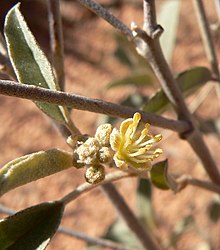
Aleurites is a small genus of arborescent flowering plants in the Euphorbiaceae, first described as a genus in 1776. It is native to China, the Indian Subcontinent, Southeast Asia, Papuasia, and Queensland. It is also reportedly naturalized on various islands as well as scattered locations in Africa, South America, and Florida.

Ambrosia dumosa, the burro-weed or white bursage, a North American species of plants in the family Asteraceae. It is a common constituent of the creosote-bush scrub community throughout the Mojave desert of California, Nevada, and Utah and the Sonoran Desert of Arizona and northwestern Mexico.
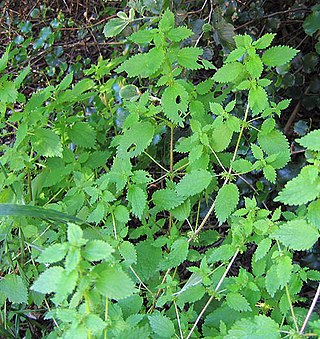
Hesperocnide tenella, also known as western nettle or western stingingnettle, is native to California and northern Baja California. It grows in chaparral, oak woodland, and coastal sage scrub communities up to 1,000 metres (3,300 ft) elevation.

Baccharis pilularis, called coyote brush, chaparral broom, and bush baccharis, is a shrub in the family Asteraceae native to California, Oregon, Washington, and Baja California. There are reports of isolated populations in New Mexico, most likely introduced.
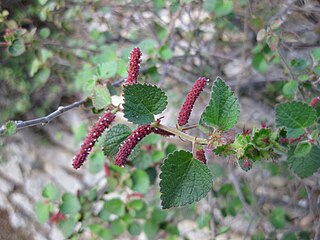
The flowering shrub Acalypha californica is known as the California copperleaf, and sometimes by the older name Pringle three-seeded mercury. It is the only Acalypha species native to California, where it is most abundant in the hills of San Diego County. It is a member of the chaparral plant community.
Croton wigginsii is a species of croton known by the common name Wiggins' croton.
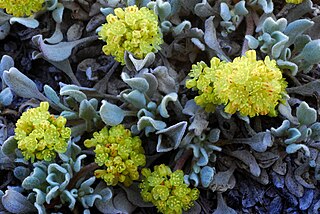
Eriogonum diclinum is a species of wild buckwheat known by the common name Jaynes Canyon buckwheat. It is native to the Klamath Mountains of northern California and southern Oregon, where it is an uncommon member of plant communities on serpentine soils. This is a small dioecious shrub forming low, thick mats rarely exceeding 20 centimeters in height. The curving, oval-shaped leaves are woolly and greenish gray in color, growing up to two centimeters long. The plant flowers in yellow to reddish rounded inflorescences, male plants producing clusters of staminate flowers, and female plants producing larger clusters of pistillate flowers.

Eriogonum marifolium is a species of wild buckwheat known by the common name marumleaf buckwheat. It is native to the Sierra Nevada and Klamath Mountains of California and the ranges' extensions into Oregon and Nevada.
Retispatha is a rare, monotypic genus of flowering plant in the palm family endemic to Borneo, where the sole species, Retispatha dumetosa, is known as wi tebu bruang or 'the bear's sugar cane'. The name combines Latin and Greek words meaning 'network' and 'spathe', and the species epithet means 'bushy'. While classified with other rattans, they retain only superficial climbing organs; they sprawl and lean but are not true climbers.
Sclerosperma is a monoecious genus of flowering plant in the palm family found in Africa where three species are known. Having no obvious relatives, it does resemble the Madagascar native Marojejya though a detailed study of Madagascar's palms is required to determine if any true relationship exists. The lack of relatives, and its interesting qualities, indicate, at one time, the existence of a diverse African palm flora. The name is from two Greek words meaning "hard" and "seed".

Krascheninnikovia lanata is a species of flowering plant in the family Amaranthaceae, known by the common name winterfat. It is native to much of western North America: from central Western Canada; through the Western United States; to northern Mexico.

Ambrosia chamissonis is a species of ragweed known by the common names silver burr ragweed, silver beachweed and (silver) beach bur(r).

Ambrosia eriocentra is a North American species of ragweed known by the common names woolly bursage and woollyfruit burr ragweed.
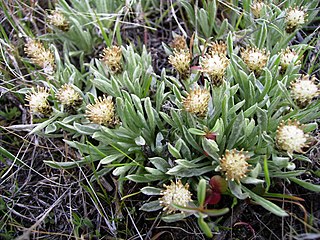
Antennaria dimorpha is a North American species of flowering plants in the family Asteraceae known by the common names low pussytoes or gray cushion pussytoes. It is native to western Canada and the western United States as far south as Riverside County in California and Rio Arriba County in New Mexico. It is generally found in dry areas. There are historical records of the species formerly occurring in northwestern Nebraska, but these populations appear now to be gone.

Antennaria flagellaris is a North American species of flowering plant in the family Asteraceae known by the common names whip pussytoes and stoloniferous pussytoes. It is native primarily to the Great Basin and Columbia Plateau regions of Washington, Oregon, Idaho, and northern Nevada, where it is a member of the sagebrush scrub plant community. Additional populations are found in northeastern California, Wyoming, the Black Hills of South Dakota, and the Canadian Province of British Columbia.
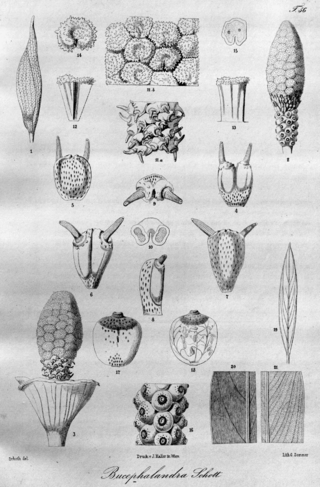
Bucephalandra is a genus of flowering plants in the family Araceae. There are 30 species of Bucephalandra which have been discovered in Borneo and have been formally described by S.Y. Wong and P.C. Boyce. Most of the species are found in Borneo. Bucephalandra are usually found growing as dense mats over stones or rocks in streams or rivers in moist tropical forest.

Carex angustata is a species of sedge known by the common name widefruit sedge. It is native to the western United States from Washington and Idaho to California, where it grows in wet meadows and on streambanks.

Euphorbia fendleri is a species of Euphorbia known by the common name Fendler's sandmat. It is native to much of the southwestern and central United States and northern Mexico, where it grows in scrub and woodland habitat in desert and plateau regions. This is a mat- or clump-forming reddish-green plant with a crooked, creeping, hairless stem. The leaves are rounded, oval, or spade-shaped, smooth along the edges and generally coming to a point, and not much more than one centimeter in maximum length. The tiny inflorescence is a cyathium with white-edged, scalloped appendages surrounding the actual flowers. There is a ring of 25 to 35 staminate flowers around one pistillate flower. The ovary of the pistillate flower enlarges into a lobed fruit about 2 millimeters long.

Calamoideae is a subfamily of flowering plant in the palm family found throughout Central America, South America, Africa, India, China, Southeast Asia and Australia. It is represented by 21 genera - containing nearly a quarter of all species in the palm family - including the largest genus, Calamus, the type genus of the group. Only four are found in the New World while the rest are Old World denizens, usually found in equatorial swampland or along tropical coastlines.
Croton yecorensis is a plant species endemic to a small region the State of Sonora, Mexico. The plant is known only from a mountainous region in the Sierra Madre Occidental in extreme eastern Sonora, only a few km from the line with Chihuahua. All the known populations lie within 60 km of one another in open rocky areas in pin-oak woodlands at elevations of 1200–1700 m.
